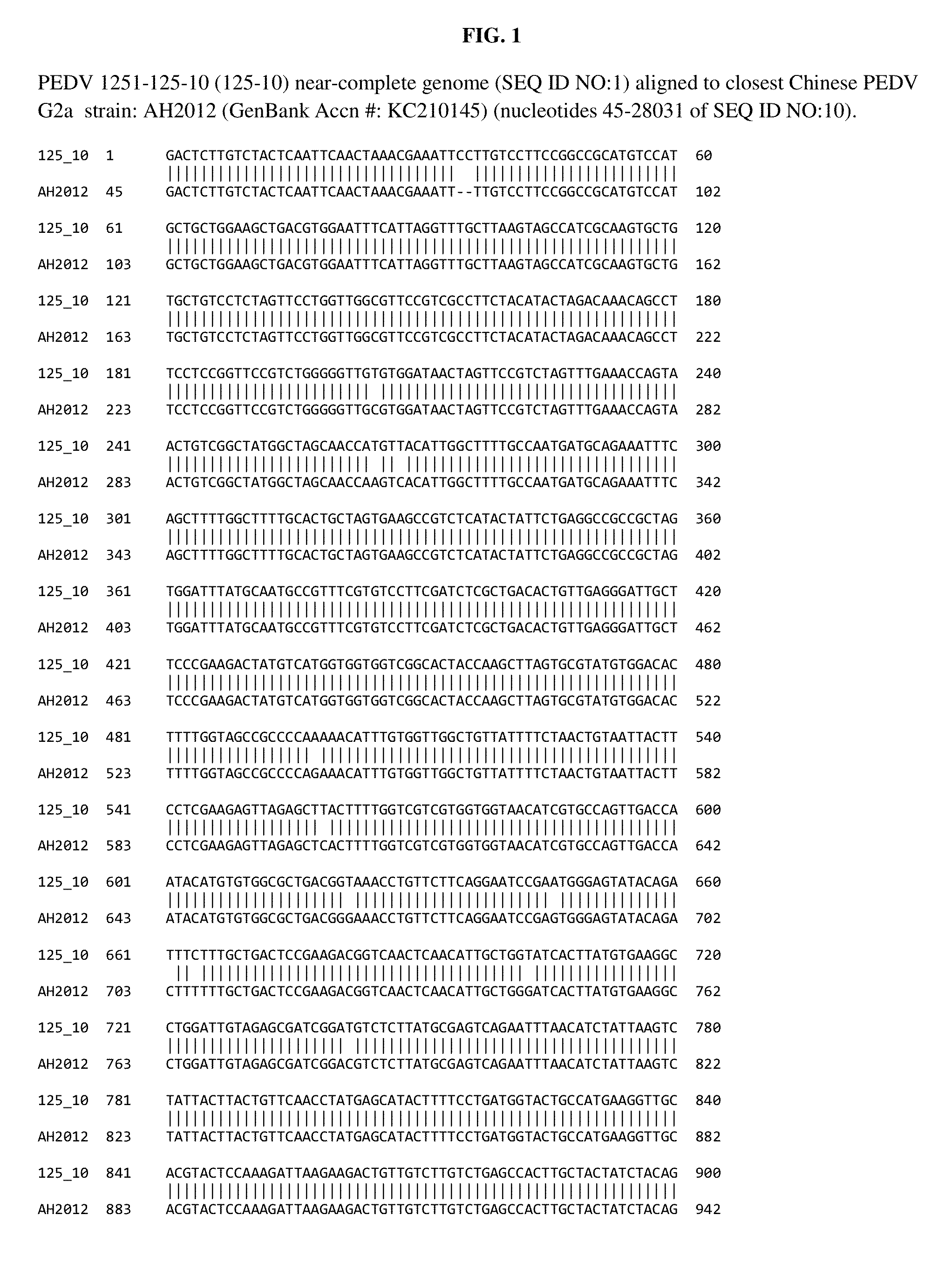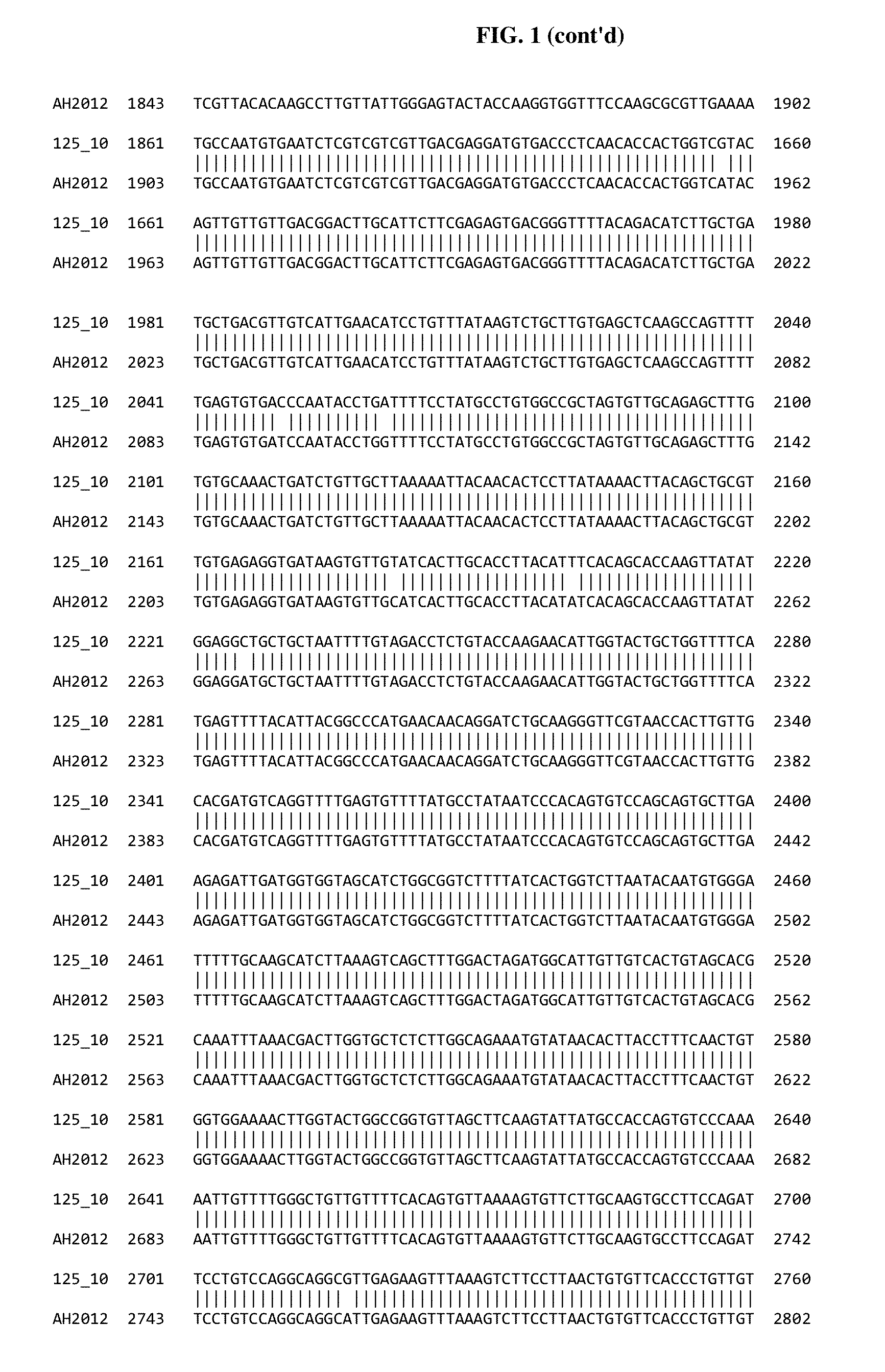Porcine epidemic diarrhea virus vaccine
a technology of diarrhea virus and vaccine, which is applied in the field of vaccine for the epidemic diarrhea virus, can solve the problems of insufficient economic importance of the disease caused by pedv, no fully licensed vaccine is commercially available in the united states, and becomes increasingly problematic, so as to reduce the level of infectious disease agent and improve the effect of symptoms
- Summary
- Abstract
- Description
- Claims
- Application Information
AI Technical Summary
Benefits of technology
Problems solved by technology
Method used
Image
Examples
example 1
Isolation and Production of Inactivated PEDV Strain
[0126]To produce the porcine epidemic diarrhea virus vaccine, killed virus, a master seed culture of a PEDV (isolate) was first produced. From this master seed, a culture of PEDV was grown and then inactivated. The inactivated virus culture was then mixed with an adjuvant in order to produce the porcine epidemic diarrhea virus vaccine. The following method was used to produce the porcine epidemic diarrhea virus vaccine.
[0127]Animals or tissues from animals exhibiting extreme diarrhea were acquired in 2013. Homogenates from mucosal scrapings were generated from these animals filtered through a 0.2 micron syringe filter and the filtrate was used to inoculate African Green Monkey kidney cells (VERO). Virus was grown in the presence of PEDV maintenance media containing modified MEM, porcine trypsin, tryptose phosphate broth, yeast extract and HEPES buffer. Virus growth was evaluated and visualized by checking for characteristic syncytia...
example 2
Genome Sequence Analysis of PEDV Isolate 1251-125-10 “125-10”
[0133]Sample Preparation and Analysis:
[0134]Prior to extraction virus tissue culture supernatants were pre-treated with a cocktail of DNase and RNase to remove residual host cell genomic nucleic acids. Viral genomic RNA was then extracted from the nuclease-treated samples using the Qiagen viral RNA extraction kit (Cat #52906). Post extraction, samples were again treated with DNase to further enrich for viral genomic RNA. Subsequently, viral genomic RNA was converted to double stranded cDNA (ds cDNA) through randomly primed reverse transcription and Klenow fragment treatment. The ds cDNA products were then used to generate a library for Illumina MiSeq-based sequencing using the NextEraXT library preparation kit (Cat #FC-131-1024). Each sample was barcoded with unique tags on both the 5′- and 3′-ends to minimize the chances of bioinformatic mis-binning. This library was run on the MiSeq using the 500-cycle kit (Cat # MS-102-...
example 3
Method of Monitoring Inactivation of Viruses
[0138]Each lot of PEDV virus or pool is tested for inactivation by passage in VERO cells. Seventy five cm2 of 24 hour cell culture are inoculated with 2.0 mL of inactivated PEDV fluids and maintained at 36±3° C. for 48 hours. One flask of VERO cells remains uninoculated. For positive virus controls one culture of VERO cells is inoculated with a positive control PEDV. At the end of the incubation period, the cell monolayers are examined for CPE typical of PEDV. The material is frozen and thawed three times and then 2 ml of each material is inoculated onto one day old VERO cells. The culture should be maintained at 37±2° C. for 48 hours. Following the second passage, a third passage is performed. After incubation and passage, the absence of virus-infected cells in the BEI treated viral fluids as determined by lack of immunofluorescence staining constitutes a satisfactory inactivation test. The control cells inoculated with the positive contr...
PUM
| Property | Measurement | Unit |
|---|---|---|
| time | aaaaa | aaaaa |
| time | aaaaa | aaaaa |
| time | aaaaa | aaaaa |
Abstract
Description
Claims
Application Information
 Login to View More
Login to View More - R&D
- Intellectual Property
- Life Sciences
- Materials
- Tech Scout
- Unparalleled Data Quality
- Higher Quality Content
- 60% Fewer Hallucinations
Browse by: Latest US Patents, China's latest patents, Technical Efficacy Thesaurus, Application Domain, Technology Topic, Popular Technical Reports.
© 2025 PatSnap. All rights reserved.Legal|Privacy policy|Modern Slavery Act Transparency Statement|Sitemap|About US| Contact US: help@patsnap.com



